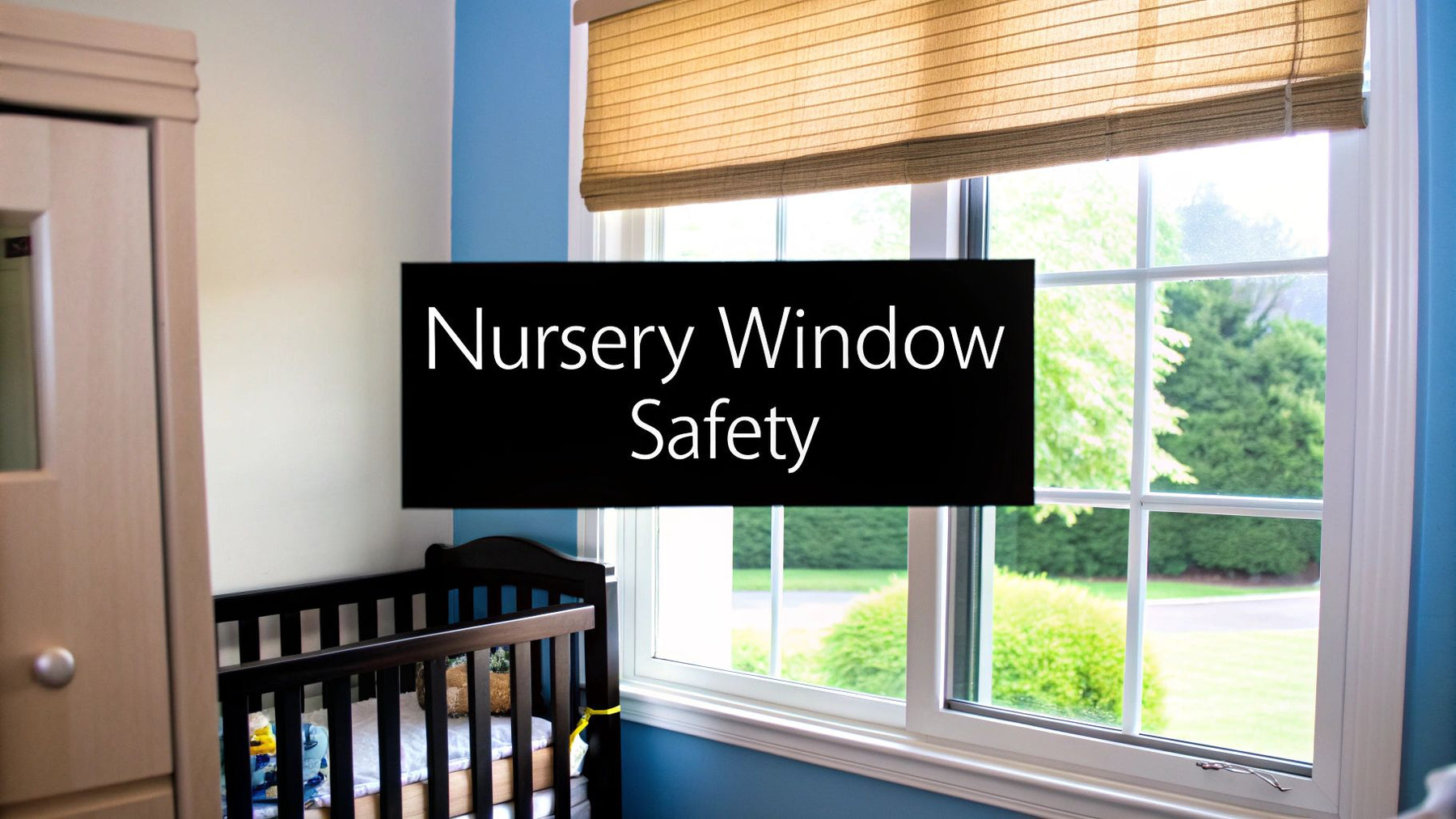
The Best Window Treatments for a Nursery: A Parent's Guide to Safety, Sleep, and Style
Choosing the right window treatments for a nursery is simpler than you think. The best options balance three critical factors: uncompromising child safety, total light control for better sleep, and a style that makes the room feel peaceful. In short, cordless designs are non-negotiable, and true blackout fabrics will quickly become your best friend for naptime.
Table of Contents
- What Should You Prioritize for Nursery Windows?
- Pillar 1: Why Child Safety is Non-Negotiable
- Pillar 2: Mastering Light Control for Better Baby Sleep
- Pillar 3: Choosing Healthy and Functional Materials
- Smart and Motorized Options: A Parent’s Secret Weapon
- How to Measure and Install Nursery Window Treatments Correctly
- Frequently Asked Questions
What Should You Prioritize for Nursery Windows?
When creating a serene, safe space for your baby, it’s easy for window treatments to become an afterthought. However, they have a huge impact on your baby's sleep, safety, and comfort. The right choice is more than just decoration; it's a critical tool for helping your baby rest soundly and stay protected.
Think of nursery window coverings as your secret weapon for a good sleep schedule. They're your first line of defense against early morning sun that can disrupt a nap schedule. Sleep experts agree that darkness helps the body produce melatonin, the sleep hormone. A truly dark room can be the difference between a full nap and a fussy, overtired baby.
We can break down the essentials into three main pillars: Safety, Light Control, and Material Health. This simple hierarchy shows you exactly what to prioritize.
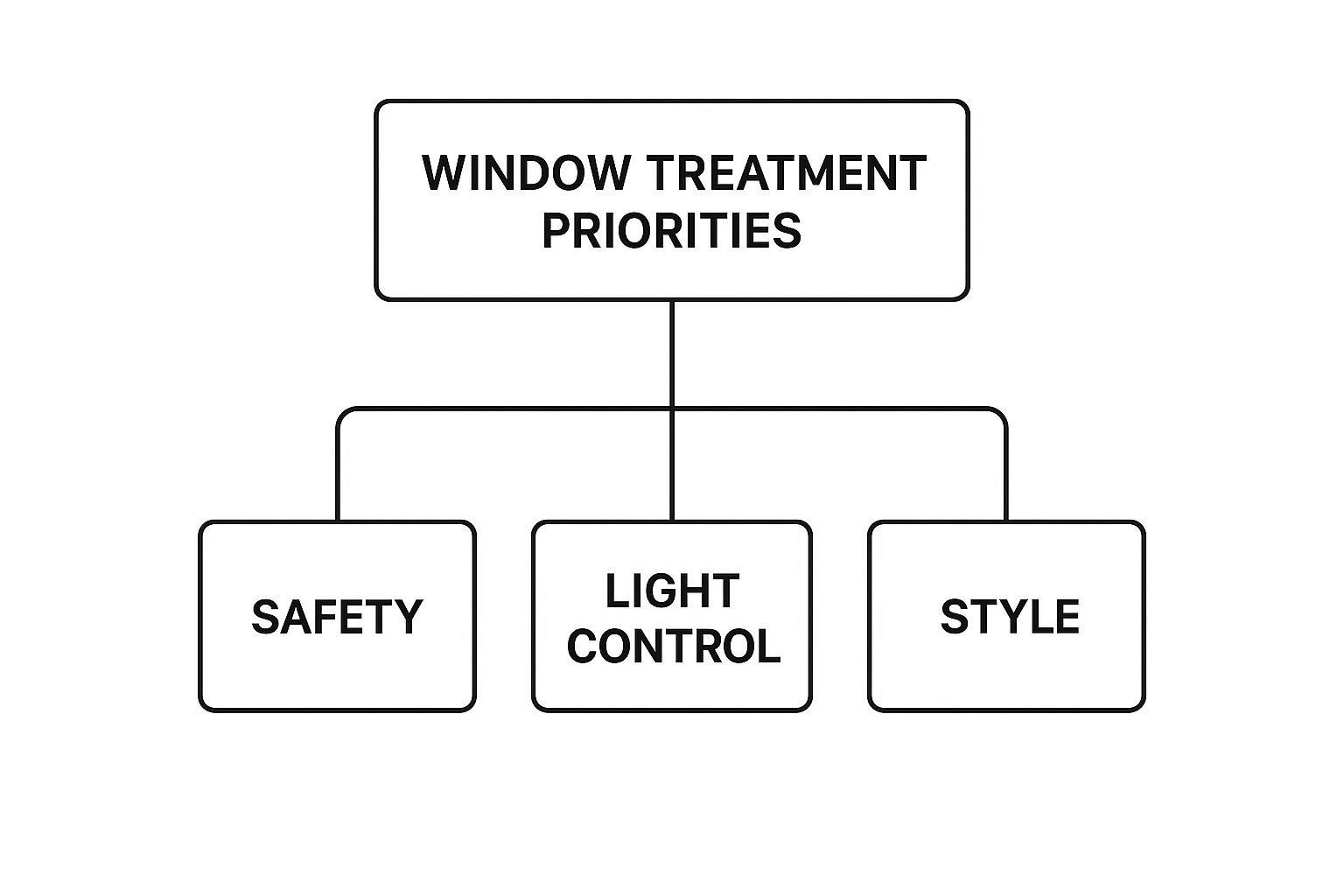
As you can see, safety is the non-negotiable foundation. After that comes light control, with style being the final, personal touch to bring it all together.
The Three Pillars of Nursery Window Treatments
Before you start looking at specific shades or curtains, understanding these core principles ensures you create a space that’s not just beautiful, but perfectly suited for your baby’s needs.
-
Uncompromising Safety: This is the most critical piece. The U.S. Consumer Product Safety Commission (CPSC) identifies corded window coverings as one of the top hidden dangers in a home. For this reason, cordless operation is the only safe choice for a nursery.
-
Mastering Light Control: A baby's sleep is delicate. Being able to make a room pitch-black for a midday nap is priceless. We’ll get into the difference between "room-darkening" and true blackout options to help you get that perfect level of darkness.
-
Health and Durability: The materials in the nursery matter. Look for fabrics that are non-toxic and easy to clean. Some options even offer thermal insulation to keep the room at a comfortable temperature or muffle outside noise.
By keeping these three priorities in mind, you can confidently pick the perfect window treatments for your nursery. You'll be creating a safe, comfortable, and restful sanctuary.
Nursery Window Treatment Decision-Making Framework
This table provides a quick overview of the top priorities when selecting nursery window treatments, helping you make an informed choice at a glance.
| Priority | Key Consideration | Recommended Option | Why It Matters for Your Baby |
|---|---|---|---|
| 1. Safety | Absence of cords or chains that pose a strangulation risk. | Cordless cellular shades, roller shades, or shutters. | Prevents accidents and creates a worry-free environment for sleep and play. |
| 2. Light Control | Ability to achieve complete darkness for naps and nighttime. | Blackout fabrics (not just room-darkening). | Promotes melatonin production and helps establish healthy sleep cycles. |
| 3. Health & Comfort | Non-toxic materials and potential for insulation or sound dampening. | GREENGUARD Certified fabrics, cellular shades for insulation. | Ensures clean indoor air quality and a stable, quiet room temperature. |
Getting these three things right will ensure you have a beautiful, functional, and—most importantly—safe space for your little one.
Pillar 1: Why Child Safety is Non-Negotiable
When designing a nursery, there’s one rule that’s absolutely non-negotiable: child safety comes first. This isn’t just a friendly suggestion—it’s the single most important factor. The hard truth is that window covering cords are a serious and preventable risk for babies and toddlers.
That’s why the only responsible choice for a nursery is a cordless design. Curious little hands can get tangled in a dangling cord in seconds. Going cordless removes this danger entirely, and that peace of mind is priceless.
This focus on safety isn't just a trend; it has reshaped the window treatment industry. Widespread awareness of cord-related dangers has driven innovation toward safer alternatives. Historically, blind cords have been linked to accidental strangulation, and the demand for safer homes is now the industry standard.
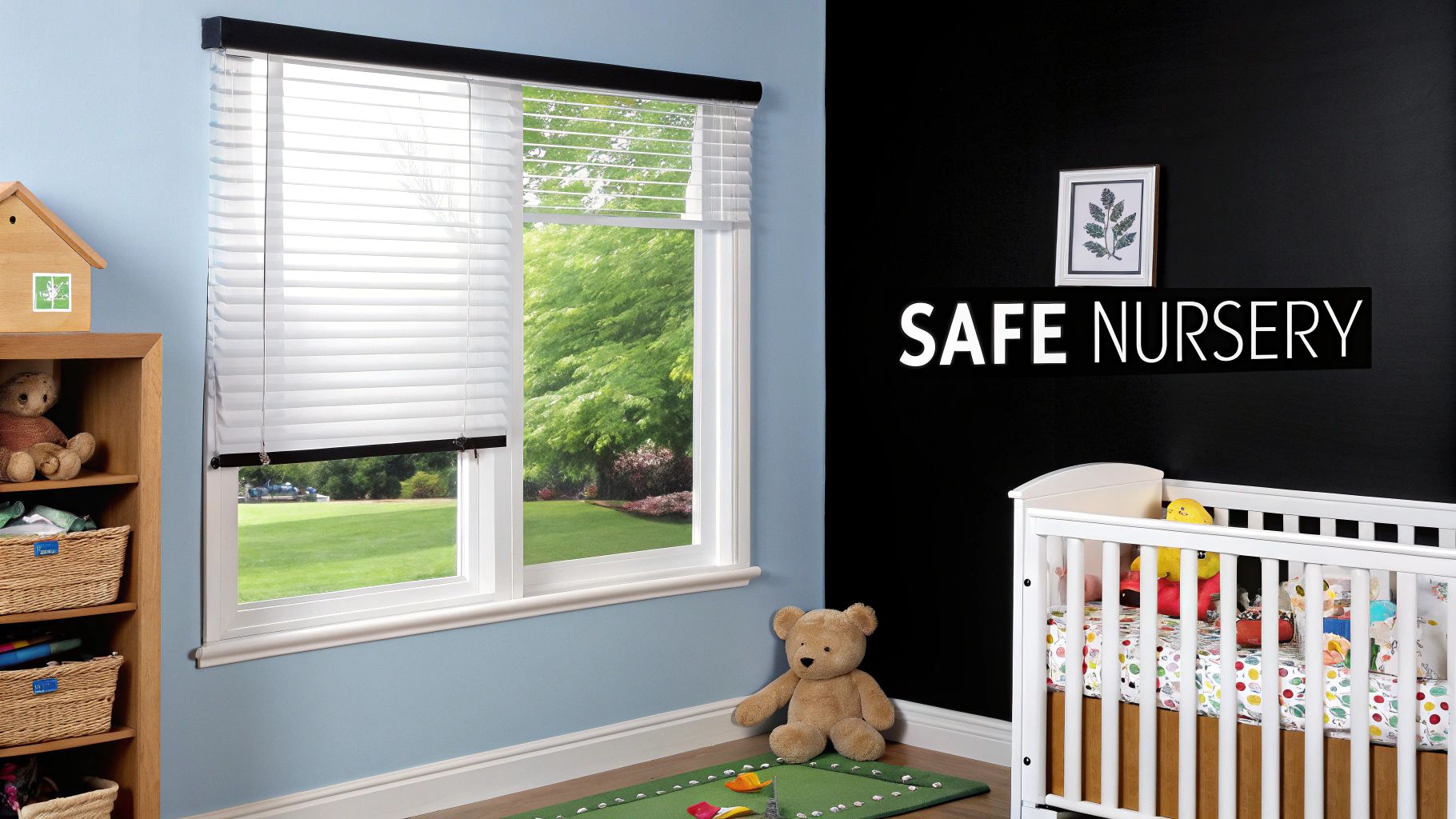
Understanding Cordless Mechanisms
Choosing a cordless option doesn't mean you’re giving up on convenience. Most modern cordless systems are smoother and easier to use than old corded ones.
- Manual Lift: The most straightforward system. Gently push up or pull down on the bottom rail to position the shade. It's intuitive, reliable, and completely free of cords.
- Wand Control: Often seen on vertical blinds. A sturdy wand replaces cords; simply twist or push the wand to adjust the blind. It's a great option that keeps controls out of a child's reach.
- Motorized Lift: The gold standard for safety and convenience. These treatments operate with a remote, wall switch, or app. It’s the perfect solution for windows behind a crib and the ultimate child-safe design.
Key Takeaway: The goal is simple: eliminate any free-hanging, looped, or dangling cords. Whether you pick a basic manual lift or a high-tech motorized system, the result is a much safer environment.
Beyond the Blinds: Secure Installation Practices
Picking the right product is just the first step. Secure installation is equally important. A window treatment that isn't installed properly can become a falling hazard. Always follow the manufacturer's instructions to the letter.
Double-check that the treatment is securely fastened to the window frame or wall. If you’re not confident in your DIY skills, hiring a professional installer is a smart investment in your child's safety and your peace of mind.
Creating a Comprehensive Safety Plan
Your window treatments are just one piece of the childproofing puzzle. The goal is to create a "safe zone" by thinking beyond just the windows.
Pay close attention to furniture placement. Never put a crib, changing table, or any furniture a toddler could climb on directly under or near a window. Even with the safest cordless blinds, an open window still poses a risk.
For a complete approach, check out this a practical guide on how to childproof your home. Taking these extra steps ensures your nursery isn’t just beautiful—it's a true sanctuary.
Pillar 2: Mastering Light Control for Better Baby Sleep
Once safety is covered, the next mission is mastering sleep. Light is the most powerful signal telling our brains when to be awake, and this is especially true for babies whose internal clocks are still developing. The right window treatments for a nursery become a parent's secret weapon for building a healthy sleep schedule.
Your baby’s circadian rhythm is an internal clock they’re just learning to set. Bright light signals "awake time," while darkness tells the brain to produce melatonin, the sleep hormone. By controlling light, you reinforce these natural cues, making it easier for your baby to distinguish between nap time and play time.
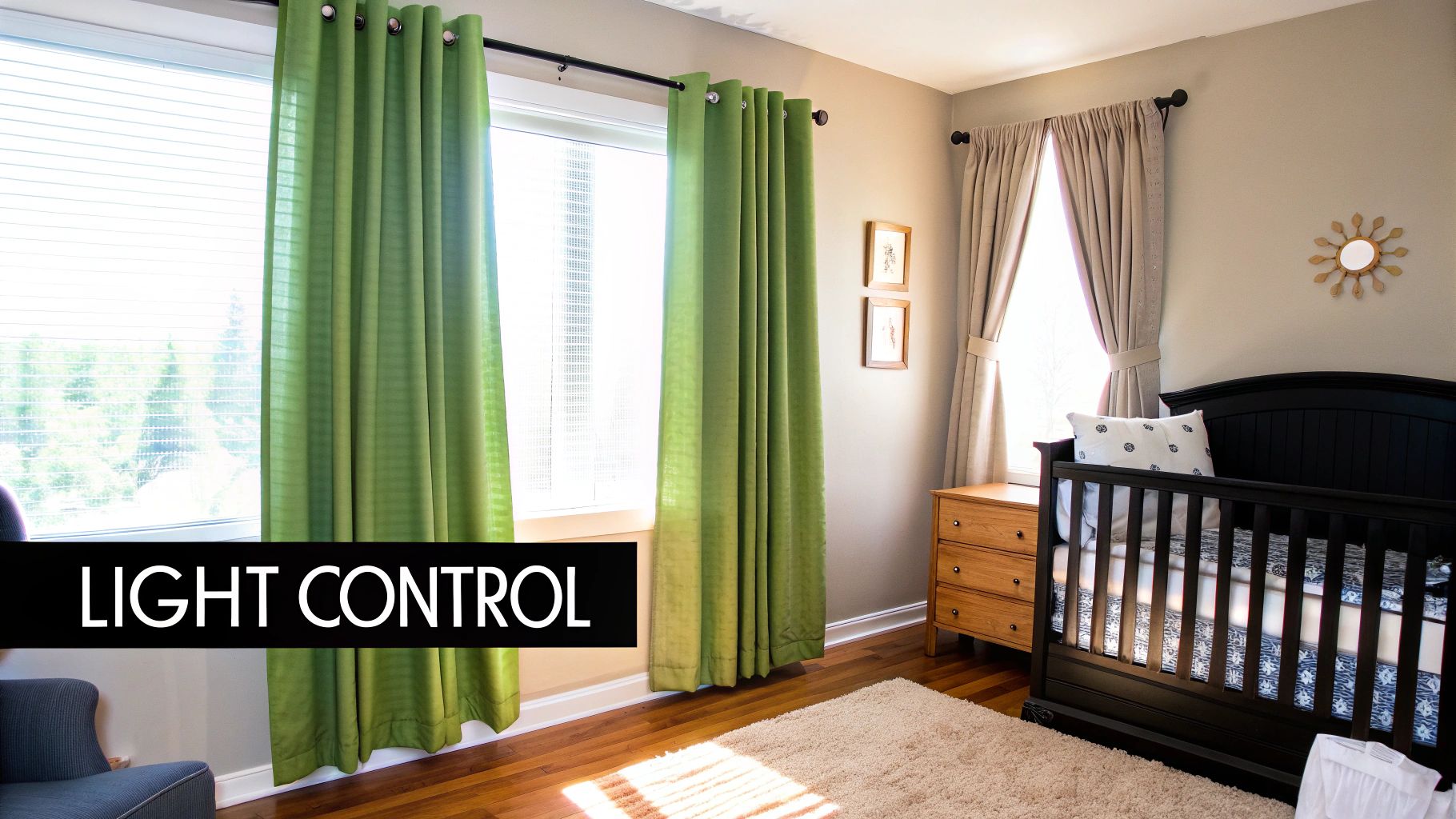
From Light Filtering to True Blackout
Not all window coverings are created equal. It’s important to know what terms like "light-filtering," "room-darkening," and "blackout" actually mean.
- Light-Filtering: These treatments softly diffuse light, cutting glare while keeping the room bright. They're great for living rooms but won't work for a nursery where deep sleep is the goal.
- Room-Darkening: This is a step up, blocking a good amount of light. However, some light will still sneak through the fabric or around the edges, creating a dim but not completely dark space.
- Blackout: This is the gold standard for nurseries. True blackout options are made with opaque materials designed to block 99% or more of incoming light, creating the pitch-black environment perfect for sleep.
Parenting Pro-Tip: Don't settle for "room-darkening" when you really need blackout. That little bit of light peeking through can be just enough to disrupt a nap or trigger an early wake-up.
Comparing Light Control Options for Your Nursery
This table compares popular options and how they stack up for creating a sleep-friendly nursery.
| Treatment Type | Light Control Level | Ideal For | Key Safety Feature |
|---|---|---|---|
| Blackout Cellular Shades | High (Blackout) | Nurseries needing insulation and darkness | Cordless lift systems are standard |
| Blackout Roller Shades | High (Blackout) | Achieving a sleek look with maximum darkness | Available in cordless or motorized options |
| Room-Darkening Drapes | Medium (Room-Darkening) | Layering over other treatments for style | Ensure tie-backs are out of reach |
| Light-Filtering Sheers | Low (Light-Filtering) | Playrooms or daytime areas, not for sleep | Not recommended for unsupervised sleep spaces |
Ultimately, for a nursery, aim for the highest level of light control to give your baby the best chance at restorative sleep.
The Best Window Treatments for a Pitch-Black Nursery
Achieving cave-like darkness is easy with the right products. Some window treatments are specifically engineered to stop light in its tracks.
Blackout Cellular Shades
These are a fantastic all-in-one solution. Their honeycomb cells offer great insulation and can be lined with a blackout material. When mounted inside the window frame, they fit snugly and minimize light gaps.
Blackout Roller Shades with Side Channels
For ultimate light-blocking power, nothing beats this combo. A standard blackout roller shade does a great job, but adding light-blocking side channels—tracks the shade slides down in—eliminates the "halo effect" of light seeping around the edges. For more ideas, check out our guide on how to block sunlight from windows.
Layered Blackout Drapery
Layering is a stylish and effective way to get total darkness. Start with a functional blackout shade mounted inside the window frame, then hang decorative blackout curtains on a wide rod over it. This double-layer approach ensures no light gets through and adds a soft, polished look.
Choosing window treatments with serious light control is an investment in your baby’s healthy development and your own sanity. A well-rested baby means a well-rested family.
Pillar 3: Choosing Healthy and Functional Materials
Once you've nailed down safety and light control, it’s time to think about the fabric itself. The materials you bring into your baby’s nursery influence everything from the air they breathe to how comfortable the room feels.
Choosing healthy, non-toxic fabrics should be a top priority. A baby’s respiratory system is still developing, making them extra sensitive to airborne chemicals. That's why it's so important to look for trusted third-party certifications when shopping.
Prioritizing Healthy Materials
When looking at fabrics, keep an eye out for labels that guarantee the product has been tested for harmful substances. These certifications offer peace of mind.
-
GREENGUARD Certification: Products with this seal have been scientifically tested to meet some of the world's toughest chemical emissions standards, reducing indoor air pollution.
-
OEKO-TEX STANDARD 100: This label means every component—from the thread to the buttons—has been checked for harmful substances and is safe for human health.
Beyond durability, opting for chemical-free materials is key. For more insights, this a guide to chemical-free baby products is a helpful resource.
Comparing Natural vs Synthetic Fabrics
Both natural and synthetic fibers have their place in a nursery. The best choice depends on what you value most: breathability, durability, or easy cleaning.
Natural Fibers (Cotton, Linen, Bamboo)
- Pros: Super breathable, soft, and usually hypoallergenic. Cotton and linen have a classic, gentle look that works beautifully in any nursery.
- Cons: Can wrinkle more easily and may require more care when cleaning. They can also be more susceptible to fading from direct sun.
Synthetic Fibers (Polyester, Vinyl)
- Pros: The undisputed champs of durability and cleanability. Polyester is tough, fade-resistant, and can often be spot-cleaned in a flash—a huge win for any nursery.
- Cons: Less breathable than natural fibers. It’s crucial to ensure any synthetic fabrics are certified non-toxic to avoid chemical "off-gassing."
Insider Tip: I often recommend a high-quality polyester blend. These fabrics offer the best of both worlds—the soft feel of natural fibers with the practical, easy-care benefits of synthetics.
More Than Just a Pretty Fabric
The right material can do more than just look good; it can make your baby’s room a more stable and peaceful place.
One valuable feature is thermal insulation. Cellular shades are a fantastic example. Their honeycomb pockets trap air, creating a barrier that helps keep the room cooler in summer and warmer in winter. This helps maintain a consistent temperature, which is a must for comfortable sleep.
Another huge benefit is noise reduction. Heavier, thicker fabrics, like those in high-quality blackout drapes, can muffle outside sounds like traffic or a barking dog. This sound-dampening effect can prevent sudden noises from waking a sleeping baby.
Smart and Motorized Options: A Parent’s Secret Weapon
Technology offers incredible tools for convenience and safety, especially in a nursery where your hands are often full. Motorized window treatments are a practical game-changer for parents.
Imagine this: you’ve finally rocked your baby to sleep, and as you tiptoe out, you notice sunlight hitting the crib. With a motorized system, you can darken the room with the quiet press of a button without risking waking your little one.
Beyond convenience, automation offers the highest level of child safety by eliminating cords entirely. This makes motorized options one of the safest window treatments for a nursery you can choose. The demand for smart home solutions is growing, with the global window coverings market on Future Market Insights showing a strong trend towards safer, automated options.
How Motorization Works in a Nursery
Controlling these treatments is simple, and you can pick the level of automation that fits your life and budget.
- Simple Remote Control: A small handheld remote is the most straightforward choice. Keep it on a nightstand to open and close shades with a single click.
- Wall Switch: A wireless wall switch can be mounted at a convenient height for adults, providing an easy-to-find control point.
- Smart Home Integration: Many motorized shades connect to smart home hubs, letting you use voice commands through assistants like Alexa or Google Home ("Hey Google, close the nursery shades").
Supporting Sleep with Automated Schedules
One of the best features of motorized window treatments is setting automated schedules. This is a huge help in regulating your baby’s sleep cycle.
By programming shades to open and close at specific times, you can gently introduce light in the morning to signal wake-up time or automatically darken the room as naptime approaches. This consistency reinforces their natural circadian rhythm.
The Investment: What to Consider
Motorization comes at a higher price than manual shades. It’s important to weigh the cost against the benefits of convenience and top-tier safety.
Most systems use long-lasting battery packs that only need recharging every 6-12 months, making them surprisingly low-maintenance. While DIY installation is possible, professional installation ensures everything works perfectly. For many parents, the added ease and safety make motorized shades a worthy investment.
How to Measure and Install Nursery Window Treatments Correctly
Getting your new window treatments to fit perfectly is all about careful measuring. A snug fit looks cleaner and boosts the light-blocking and safety features you've chosen.
Before you touch that tape measure, decide if you want an inside mount or an outside mount.
- Inside Mount: The shade fits snugly inside the window casing for a clean, built-in look. It’s fantastic for minimizing light gaps.
- Outside Mount: The treatment is installed on the wall or trim above and around the window. It’s a great fix for imperfect window frames or to create the illusion of a larger window.
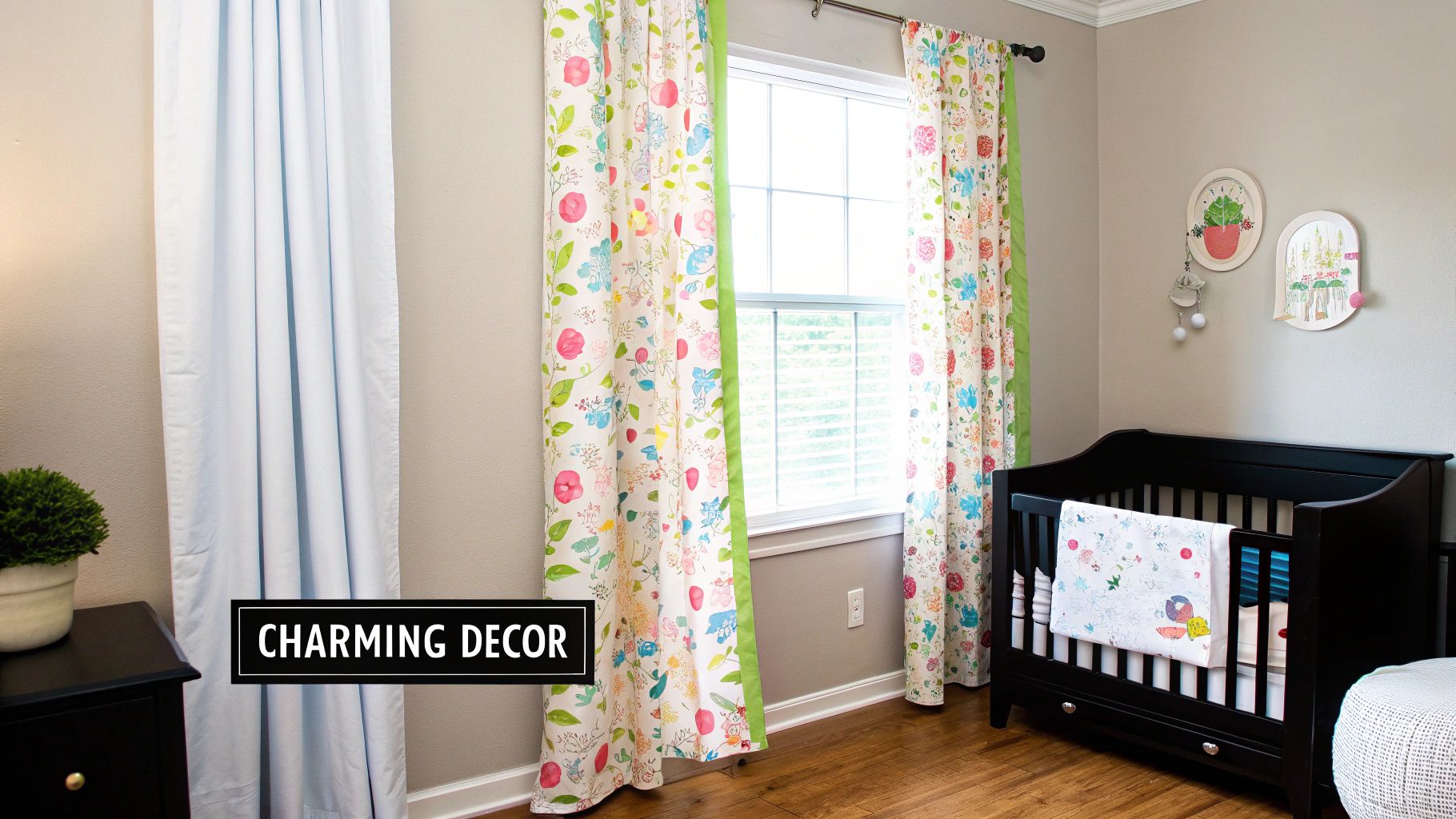
A Simple Guide to Measuring
Accuracy is everything. Measure twice, order once. And please, use a steel tape measure, as fabric ones can stretch.
For a deep dive, check out our complete guide on how to measure windows for blinds.
For an Inside Mount
- Width: Measure the inside width of the window frame at the top, middle, and bottom. Record the narrowest of these three numbers. This ensures the shade won't get stuck.
- Height: Measure the height on the left, in the middle, and on the right. Record the longest of the three measurements.
For an Outside Mount
- Width: Measure the full width you want to cover, including the frame. I recommend adding at least 1.5 to 3 inches to each side to block as much light as possible.
- Height: Decide how high above the frame you want the headrail. Measure from that spot down to where you want the treatment to end.
Safe and Secure Installation
When your new window treatments arrive, the final step is installation. In a nursery, a securely installed treatment is a safe one.
Safety First: Always use the hardware that comes from the manufacturer. Anchor the brackets firmly into a wall stud or use the proper wall anchors. A wobbly installation is an unsafe one.
If you’re dealing with a tricky window or setting up a motorized system, calling a professional is a wise choice. Their expertise guarantees the installation is not just flawless but completely secure.
Frequently Asked Questions
What are the safest window treatments for a nursery?
The safest window treatments for a nursery are any type that is completely cordless. This eliminates the strangulation risk posed by dangling cords. Top choices include cordless cellular shades, cordless roller shades, shutters, and motorized shades, all of which offer excellent safety and functionality.
Are cellular shades a good choice for a nursery?
Yes, cordless cellular shades are an excellent choice. Their cordless design is inherently safe. Additionally, their unique honeycomb shape provides superior insulation, helping to maintain a stable room temperature. They are widely available in blackout fabrics, making them ideal for creating the dark, quiet environment babies need for sleep.
How can I make existing corded blinds safer?
The only truly safe solution is to replace corded blinds with a certified cordless option. If immediate replacement isn't possible, you must secure the cords. Install cord cleats high on the wall to wrap cords tightly and out of reach. For continuous loop cords, use a tension device to hold the cord taut. These are temporary fixes; replacement is the best long-term solution.
Which materials are easiest to clean?
For easy cleaning, vinyl and faux wood blinds are top contenders as they can be wiped down with a damp cloth. If you prefer fabric shades, durable polyester blends are often stain-resistant and can be spot-cleaned with mild soap and water. Always check the manufacturer's care instructions first.
Ready to create that perfect safe and serene space for your little one? Explore the beautiful and child-safe collection of nursery window treatments at Joey'z Shopping. Find the ideal solution for your family at https://joeyzshopping.com.
